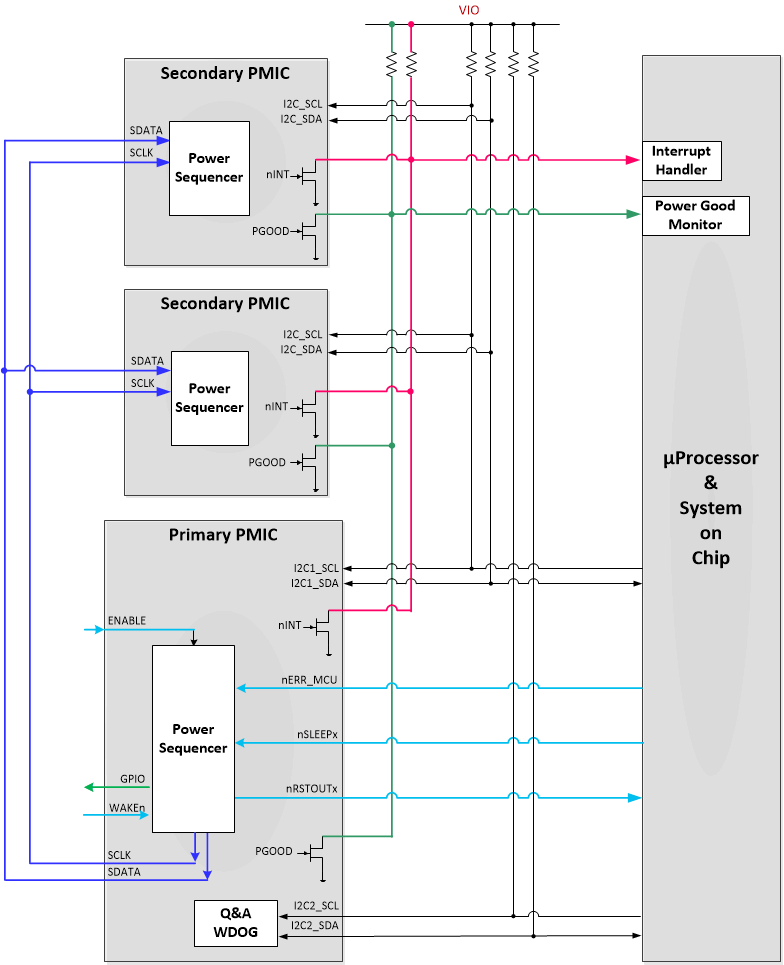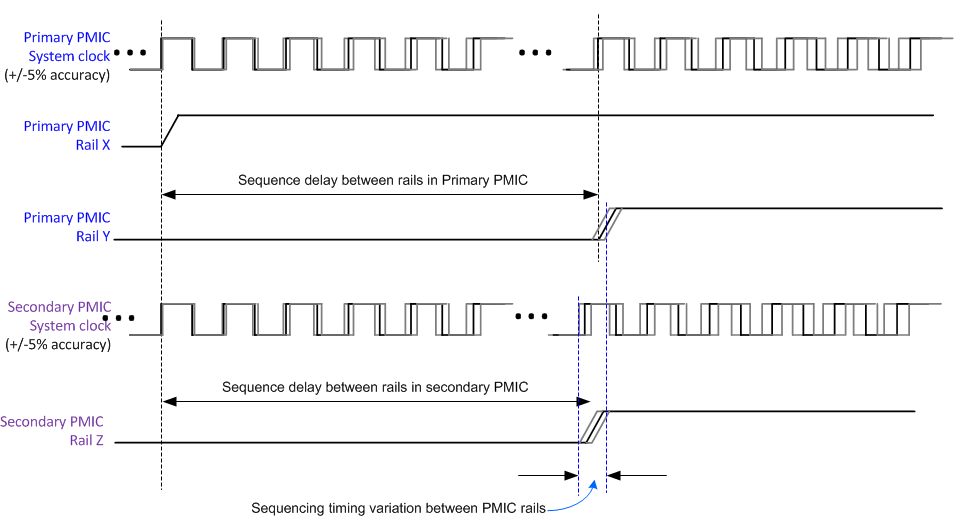ZHCSR22A June 2021 – September 2022 LP876242-Q1
PRODUCTION DATA
- 1 特性
- 2 应用
- 3 说明
- 4 Revision History
- 5 Pin Configuration and Functions
-
6 Specifications
- 6.1 Absolute Maximum Ratings
- 6.2 ESD Ratings
- 6.3 Recommended Operating Conditions
- 6.4 Thermal Information
- 6.5 Internal Low Drop-Out Regulators (LDOVINT)
- 6.6 BUCK1, BUCK2, BUCK3, and BUCK4 Regulators
- 6.7 Reference Generator (REFOUT)
- 6.8 Monitoring Functions
- 6.9 Clocks, Oscillators, and DPLL
- 6.10 Thermal Monitoring and Shutdown
- 6.11 System Control Thresholds
- 6.12 Current Consumption
- 6.13 Digital Input Signal Parameters
- 6.14 Digital Output Signal Parameters
- 6.15 I/O Pullup and Pulldown Resistance
- 6.16 I2C Interface
- 6.17 Serial Peripheral Interface (SPI)
- 25
- 6.18 Typical Characteristics
-
7 Detailed Description
- 7.1 Overview
- 7.2 Functional Block Diagram
- 7.3
Feature Description
- 7.3.1 Input Voltage Monitor
- 7.3.2 Power Resources
- 7.3.3 Residual Voltage Checking
- 7.3.4 Output Voltage Monitor and PGOOD Generation
- 7.3.5 General-Purpose I/Os (GPIO Pins)
- 7.3.6 Thermal Monitoring
- 7.3.7 Interrupts
- 7.3.8
Watchdog (WD)
- 7.3.8.1 Watchdog Fail Counter and Status
- 7.3.8.2 Watchdog Start-Up and Configuration
- 7.3.8.3 MCU to Watchdog Synchronization
- 7.3.8.4 Watchdog Disable Function
- 7.3.8.5 Watchdog Sequence
- 7.3.8.6 Watchdog Trigger Mode
- 7.3.8.7 WatchDog Flow Chart and Timing Diagrams in Trigger Mode
- 55
- 7.3.8.8 Watchdog Question-Answer Mode
- 7.3.9 Error Signal Monitor (ESM)
- 7.4
Device Functional Modes
- 7.4.1
Device State Machine
- 7.4.1.1 Fixed Device Power FSM
- 7.4.1.2
Pre-Configurable Mission States
- 7.4.1.2.1
PFSM Commands
- 7.4.1.2.1.1 REG_WRITE_IMM Command
- 7.4.1.2.1.2 REG_WRITE_MASK_IMM Command
- 7.4.1.2.1.3 REG_WRITE_MASK_PAGE0_IMM Command
- 7.4.1.2.1.4 REG_WRITE_BIT_PAGE0_IMM Command
- 7.4.1.2.1.5 REG_WRITE_WIN_PAGE0_IMM Command
- 7.4.1.2.1.6 REG_WRITE_VOUT_IMM Command
- 7.4.1.2.1.7 REG_WRITE_VCTRL_IMM Command
- 7.4.1.2.1.8 REG_WRITE_MASK_SREG Command
- 7.4.1.2.1.9 SREG_READ_REG Command
- 7.4.1.2.1.10 SREG_WRITE_IMM Command
- 7.4.1.2.1.11 WAIT Command
- 7.4.1.2.1.12 DELAY_IMM Command
- 7.4.1.2.1.13 DELAY_SREG Command
- 7.4.1.2.1.14 TRIG_SET Command
- 7.4.1.2.1.15 TRIG_MASK Command
- 7.4.1.2.1.16 END Command
- 7.4.1.2.2 Configuration Memory Organization and Sequence Execution
- 7.4.1.2.3 Mission State Configuration
- 7.4.1.2.4 Pre-Configured Hardware Transitions
- 7.4.1.2.1
PFSM Commands
- 7.4.1.3 Error Handling Operations
- 7.4.1.4 Device Start-up Timing
- 7.4.1.5 Power Sequences
- 7.4.1.6 First Supply Detection
- 7.4.2 Multi-PMIC Synchronization
- 7.4.1
Device State Machine
- 7.5 Control Interfaces
- 7.6 NVM Configurable Registers
- 7.7 Register Map
- 8 Application and Implementation
- 9 Device and Documentation Support
- 10Mechanical, Packaging, and Orderable Information
7.4.2 Multi-PMIC Synchronization
A multi-PMIC synchronization scheme is implemented in the LP876242-Q1 device to synchronize the power state changes with other PMIC devices. This feature consolidates and simplifies the IO control signals required between the application processor or the microcontroller and multiple PMICs in the system. The control interface consists of an SPMI protocol that communicates the next power state information from the primary PMIC to up to 5 secondary PMICs, and receives feedback signal from the secondary PMICs to indicate any error condition or power state information. Figure 7-41 is the block diagram of the power state synchronization scheme. The primary PMIC in this block diagram is responsible for broadcasting the synchronous system power state data, and processing the error feedback signals from the secondary PMICs. The primary PMIC is the controller device on the SPMI bus, and the secondary PMICs are the target devices on the SPMI bus.
In this scheme, each primary and secondary PMIC runs on its own system clock, and maintains its own register map. Each PMIC monitors its own activities and pulls down the open-drain output of nINT or PGOOD pin when errors are detected. The microprocessor must read the status bits from each PMIC device through the I2C or SPI interface to find out the source of the error that is reported.
Figure 7-42 illustrates the pin connections between the primary, the secondary, and the application processor or the System-on-Chip.
 Figure 7-42 Multi-PMIC Pin
Connections
Figure 7-42 Multi-PMIC Pin
ConnectionsThe power sequencer of the multiple PMICs are synchronized at the beginning of each power up and power down sequence; a variation in the sequence timing, however, is still possible due to the ±5% clock accuracy of the independent system clocks on the primary and secondary PMICs. The worst-case sequence timing variation from different PMIC rails is up to ±10% of the target delay time. Figure 7-43 illustrates the creation of this timing variation between PMICs.
 Figure 7-43 Multi-PMIC Rail Sequencing
Timing Variation
Figure 7-43 Multi-PMIC Rail Sequencing
Timing Variation